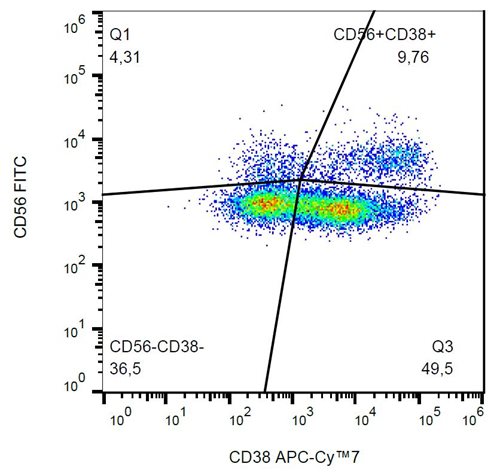Anti-CD29 / Integrin beta1 chain Monoclonal Antibody (Clone:MEM-101A)-PE Conjugated

Figure 1: Surface staining of human peripheral blood with anti-human CD29 (MEM-101A) PE.
Roll over image to zoom in
Shipping Info:
For estimated delivery dates, please contact us at [email protected]
| Amount : | 100 tests |
| Isotype : | Mouse IgG1 |
| Storage condition : | Store in the dark at 2-8°C. Do not freeze. Avoid prolonged exposure to light. |
CD29 (beta1 integrin subunit, GPIIa) forms non-covalently linked heterodimers with at least 6 different alpha chains (alpha1-alpha6, CD49a-f) determining the binding properties of beta1 (VLA) integrins. These integrins mediate cell adhesion to collagen, fibronectin, laminin and other extracellular matrix (ECM) components. This interaction hinders cell death, whereas disruption of anchorage to ECM leads to apoptosis. Decreased expression of most beta1 integrins correlates with acquiring multidrug resistance of tumour cells during selection in presence of antitumour drug. In platelets, translocation of intracellular pool of beta1 integrins to the plasma membrane following thrombin stimulation. These integrins are also up-regulated in leukocytes during emigration and extravascular migration and appear to be critically involved in regulating the immune cell trafficking from blood to tissue, as well as in regulating tissue damage and disease symptoms related to inflammatory bowel disease. Through a beta1 integrin-dependent mechanism, fibronectin and type I collagen enhance cytokine secretion of human airway smooth muscle in response to IL-1beta.
| Subcellular location: | Cell membrane, Cell junction |
| Post transnational modification: | The cysteine residues are involved in intrachain disulfide bonds. |
| Tissue Specificity: | Isoform 1 is widely expressed, other isoforms are generally coexpressed with a more restricted distribution. Isoform 2 is expressed in skin, liver, skeletal muscle, cardiac muscle, placenta, umbilical vein endothelial cells, neuroblastoma cells, lymphoma cells, hepatoma cells and astrocytoma cells. Isoform 3 and isoform 4 are expressed in muscle, kidney, liver, placenta, cervical epithelium, umbilical vein endothelial cells, fibroblast cells, embryonal kidney cells, platelets and several blood cell lines. Isoform 4, rather than isoform 3, is selectively expressed in peripheral T-cells. Isoform 3 is expressed in non-proliferating and differentiated prostate gland epithelial cells and in platelets, on the surface of erythroleukemia cells and in various hematopoietic cell lines. Isoform 5 is expressed specifically in striated muscle (skeletal and cardiac muscle). |
| BioGrid: | 109894. 111 interactions. |
|
There are currently no product reviews
|



















.png)










